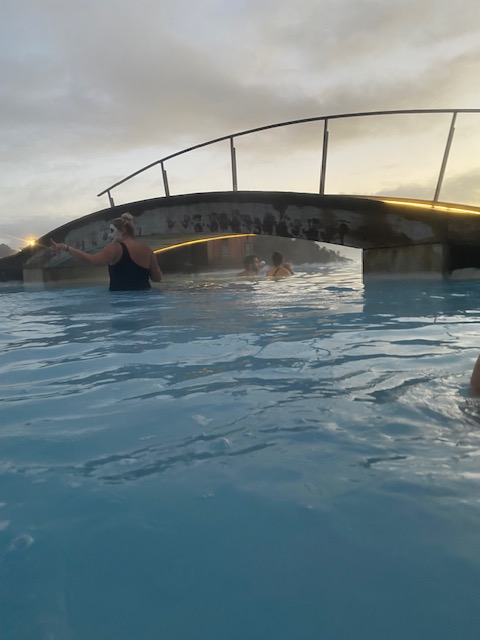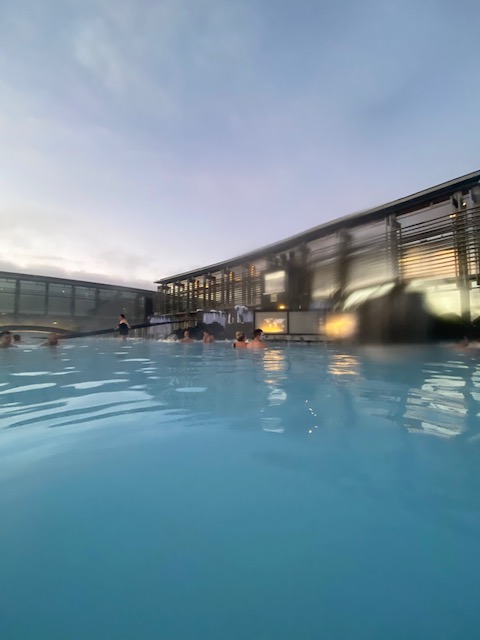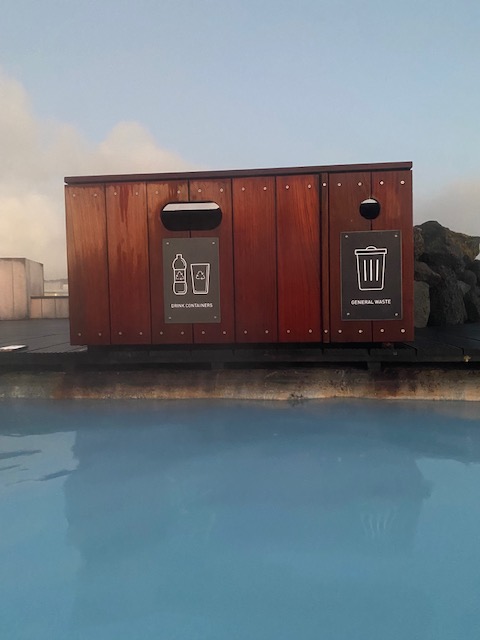Iceland in November and December? Really? I saw an Icelandair promotion on Instagram which I couldn’t resist. The catch? It had to be late November to the start of December 2022. But I could – easily – enthuse Oriol to come along for a road trip in the South and West of Iceland.
The Blue Lagoon or Bláa lónið is a geothermal spa in southwestern Iceland. The spa is located in a lava field near Grindavík and in front of Mount Þorbjörn on Reykjanes Peninsula, in a location favourable for geothermal power, and is supplied by water used in the nearby Svartsengi geothermal power station. The Blue Lagoon is approximately 20 km (12 mi) from Keflavík International Airport, and is one of the most visited attractions in Iceland.
The water’s milky blue shade is due to its high silica content. The silica forms soft white mud on the bottom of the lake which bathers rub on themselves. The water is also rich in salts and algae.[3]
The water temperature in the bathing and swimming area of the lagoon averages 37–39 °C (99–102 °F).
Guests are required to shower bare naked prior to using the geothermal spa. Which not everyone does.
The communal showers are split up by gender.
Children age 8 and under are only allowed entry with the use of arm floaters, provided free of charge. The lagoon is not suitable for children under the age of 2 years.
The lagoon is accessible for wheelchair users with a ramp that extends into the water and a shower chair. There is also a private changing room available for those with special needs.
The lagoon is man-made. The water is a byproduct from the nearby geothermal power plant Svartsengi where superheated water is vented from the ground near a lava flow and used to run turbines that generate electricity. After going through the turbines, the steam and hot water passes through a heat exchanger to provide heat for a municipal water heating system. Then the water is fed into the lagoon.
The rich mineral content is provided by the underground geological layers and pushed up to the surface by the hot water (at about 1.2 MPa (12 bar) pressure and 240 °C (464 °F) temperature) used by the plant. Because of its mineral concentration, water cannot be recycled and must be disposed of in the nearby landscape, a permeable lava field that varies in thickness from 50 cm (20 in) to 1 m (3.3 ft). After the minerals have formed a deposit, the water reinfiltrates the ground, but the deposits render the ground impermeable over time, so the plant needs to continuously dig new ponds in the nearby lava field.
The water renews every two days. The average pH value is 7.5 and the salt content is 2.5%. Very few organisms live in the water apart from some blue-green algae, despite the water not being artificially disinfected it contains no fecal bacteria, environmental bacteria, fungi, or plants.




Coincidence
Shortly after the opening of the Svartsengi power plant in 1976, the runoff water had made pools. In 1981, a psoriasis patient bathed in the water and noted that the water alleviated his symptoms and the lagoon subsequently became popular.
Bathing facilities opened in 1987 and in 1992 the Blue Lagoon company was established.
Studies made in the 1990s confirmed that the lagoon had a beneficial effect on the skin disease psoriasis. A psoriasis clinic was opened in 1994 and in 1995, the Blue Lagoon company began marketing skin products containing silica, algae, and salt.
The lagoon recorded 1.3 million visitors in 2017, up from 919,000 visitors in 2015.The company had a revenue of €102 million and a profit of €31 million in 2017. It has over 600 employees.
The entry fee varies depending on the time of day you book your slot.
A factory
The Blue Lagoon is a huge tourist factory. It’s all well organised and you’re made feel welcome, but it remains too ‘industrial’. In a way it’s too well organised. You’re ushered through the gates and to the change rooms and then the showers. Then you’re ushered to the pool.

How is it?
The ‘comfort’ offering we booked includes one drink at the pool bar and and a portion of silica cream to put on your face. The silica is supposed to be good for your skin.
I found my skin to feel dry afterwards. It also felt like putting skyr on my face. I’m not a cosmetics fan anyway. The sparkling wine was terrible.
But the pool is big and the water is nice.
But it’s just so touristy. It’s such an ‘Instagram place’ to be. Everyone is taking pictures, including us. Someone was recording some commercial (crypto) video.
Speaking of which, our waterproof cellphone protection bags didn’t like the water. It was hard to use our phones.

So?
Yes, the Blue Lagoon is a great photogenic activity and bathing in warm water outside is fun. But it’s so touristy. It’s also expensive. Even for Iceland. I’d recommend looking for less obvious hot springs or warm outside pools.
Iceland, November & December 2022
- REVIEW | Icelandair Brussels Airport (Zaventem) to Reykjavík (Keflavík International Airport) on Boeing 737 MAX 8 in Economy.
- ICELAND | Kevlavík – Bridge Between Continents – Reykjanesviti Lighthouse – Reykjanestá – Gunnuhver Hot Springs – Grindavík – Reykjavík.
- REVIEW | Hotel Cabin in Reykjavík.
- ICELAND | Seljalandsfoss Waterfall – Skógafoss – Sólheimajökull – Dyrhólaeyjarviti – Reynisfjara – Vík.
- REVIEW | Hotel Katla in Vík.
- ICELAND | Skeiðará Bridge – Diamond Beach – Jökulsárlón – Skaftafellsjökull – Dverghamrar – Kirkjugólf – Fjaðrárgljúlfur – Skaftáreldahraun.
- ICELAND | Aurora Borealis or Northern Lights at Reynisfjara Black Sand Beach near Vík.
- ICELAND | Fjaðrárgljúlfur – DC-3 Plane Wreck at Sólheimasandur – Geysir – Gullfoss.
- ICELAND | Secret Lagoon in Flúðir.
- REVIEW | Guesthouse Flúðir.
- ICELAND | Þingvellir or Thingvellir National Park – Hvalfjörður Fjord – Húsafell.
- REVIEW | Guesthouse Bjarg in Borgarnes.
- ICELAND | Eldborg Crater – Bjarnarfoss – Búðakirkja – Arnarstapi – Hellnar – Djúpalónssandur – Kirkjufell – Stykkishólmur.
- ICELAND | Esja(n) – Úlfarsfell – Krýsuvík – Seltún Geothermal Hot Springs.

I hadn’t realised that the water is from the nearby power plant- interesting
I’d love to go here someday
Great post
LikeLiked by 1 person
Somehow it made me think of Springfield Nuclear Power Plant ;-). Luckily I didn’t came home with a third eye.
LikeLiked by 1 person